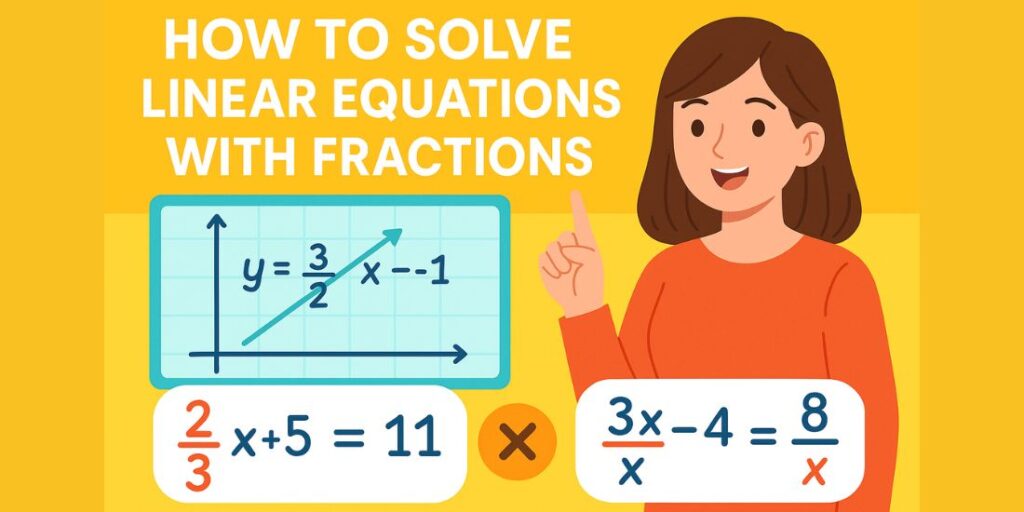Linear equations are foundational tools in algebra that unlock the power of mathematical thinking in both academic studies and everyday applications. Whether you’re a student starting algebra or someone revisiting math for a career change or test prep, understanding how to solve linear equations is an essential skill. This detailed guide will cover multiple methods of solving linear equations, including those with fractions, substitution techniques, graphical approaches, and real-life word problems.
What Is a Linear Equation?
A linear equation is an algebraic expression where the highest power of the variable is 1. The general form is:
ax + b = c
Where:
- x is the variable
- a, b, and c are constants
- The equation represents a straight line when graphed
Learning to solve linear equations involves manipulating the equation to isolate the variable and find its value.
Step-by-Step: How To Solve Basic Linear Equations
Step 1: Simplify Both Sides
Remove parentheses and combine like terms.
Step 2: Move Variables to One Side
Use addition or subtraction to get all variable terms on one side of the equation.
Step 3: Isolate the Variable
Use inverse operations to solve for the variable.
Example:
2x + 3 = 11
- Subtract 3 from both sides: 2x = 8
- Divide both sides by 2: x = 4

How to Solve Linear Equations with Fractions
Tip 1: Eliminate Fractions First
Multiply both sides by the Least Common Denominator (LCD).
Example:
1/2x + 1/3 = 5/6
- LCD = 6
- Multiply each term by 6: 3x + 2 = 5
- Subtract 2: 3x = 3
- Divide by 3: x = 1
This method keeps your work clean and avoids mistakes common when dealing with multiple fractions.
How to Solve Linear Equations by Substitution
Used for systems of linear equations, the substitution method involves:
Step 1: Solve One Equation for One Variable
Express one variable in terms of the other.
Step 2: Substitute into the Second Equation
Replace the variable with the expression you found.
Step 3: Solve the New Equation
Then back-substitute to find the other variable.
Example:
Given:
x + y = 10
x – y = 4
- From the first: x = 10 – y
- Substitute into second: (10 – y) – y = 4 → 10 – 2y = 4
- Solve: y = 3
- Back-substitute: x = 10 – 3 = 7
Answer: x = 7, y = 3
How to Solve Linear Equations Graphically
Solving graphically means plotting the equations and finding their intersection point.
Step-by-Step:
- Convert equations to slope-intercept form: y = mx + b
- Graph both equations on a coordinate plane.
- The point where the lines intersect is the solution.
Example:
y = 2x + 1
y = -x + 4
- Graph both.
- They intersect at (1, 3)
Answer: x = 1, y = 3
This method is ideal for visual learners and useful in real-world problems like analyzing trends.
How to Solve Linear Equations Word Problems?
Word problems require converting language into math expressions. Here’s the strategy:
Step-by-Step:
- Read Carefully: Understand what’s given and what’s asked.
- Define Variables: Assign variables to unknowns.
- Write the Equation: Translate the problem into an algebraic equation.
- Solve: Use algebraic techniques.
- Check and Interpret: Verify the solution and ensure it makes sense in context.
Example:
A total of $1,200 is divided into two parts. One part earns 5% interest and the other earns 7%. The total interest is $74. How much is invested at each rate?
Let:
- x = amount at 5%
- 1200 − x = amount at 7%
Equation:
0.05x + 0.07(1200 − x) = 74
Solve:
0.05x + 84 − 0.07x = 74
−0.02x = −10 ⇒ x = 500
Answer: $500 at 5%, $700 at 7%
Common Mistakes to Avoid While Solving Linear Equations
- Not applying operations to both sides: Always maintain balance.
- Miscalculating with negatives and fractions: Watch signs and simplify carefully.
- Forgetting to simplify expressions before solving.
- Skipping steps: Leads to errors, especially in word problems and systems.
Practice Tips to Master Linear Equations
- Start with simple problems to build confidence.
- Use graphing calculators or apps for visual insight.
- Practice real-life word problems for application.
- Use math workbooks and online platforms like Khan Academy, Mathway, or BYJU’S.
Conclusion
Whether you’re dealing with single-variable algebra or complex systems, knowing how to solve linear equations is a core skill in mathematics. Mastering techniques like handling fractions, using substitution, graphing methods, and decoding word problems gives you a solid foundation for advanced math and real-life problem-solving.
For more educational content on algebra and math mastery, visit our blog site Pure Acad, your destination for learning made simple.









